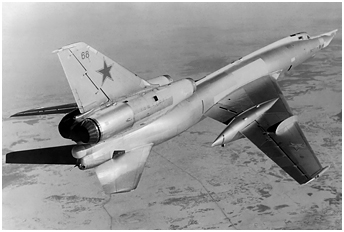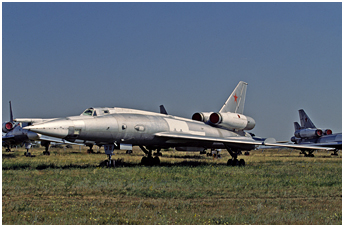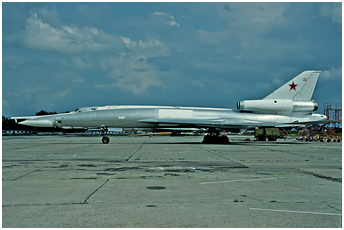 The Tu-22 "Blinder" have been much less frequently observed in GDR than the Tu-16 and the Tu-22M2 - and to a lesser extent the Tu-22M3 - probably because they landed
less often on local airfields. They were nevertheless present in the heavens above East-Germany. That was particularly the case for the Tu-22R
"Blinder-C" (1). Reconnaissance flights over the Baltic Sea followed a rather complex route that permitted to cover more
targets. The aircraft flew indeed through Poland to reach Czechoslovakia and finally the GDR. The "Blinder" went up along the inter-German border
before finally reaching the Baltic Sea (2) where they were generally intercepted by Swedish SAAB Draken and Viggen.
When the latter escorted the Tu-22 a little bit too long, the Soviet crews called to the rescue the fighters of the 871.IAP based at Kolobrzeg in Poland, near the shore of the Baltic Sea.
As the Swedish were more than likely listening to the the Soviet communications, this call for assistance launched on the airwaves could be enough to sent away the
interceptors.
The Tu-22 "Blinder" have been much less frequently observed in GDR than the Tu-16 and the Tu-22M2 - and to a lesser extent the Tu-22M3 - probably because they landed
less often on local airfields. They were nevertheless present in the heavens above East-Germany. That was particularly the case for the Tu-22R
"Blinder-C" (1). Reconnaissance flights over the Baltic Sea followed a rather complex route that permitted to cover more
targets. The aircraft flew indeed through Poland to reach Czechoslovakia and finally the GDR. The "Blinder" went up along the inter-German border
before finally reaching the Baltic Sea (2) where they were generally intercepted by Swedish SAAB Draken and Viggen.
When the latter escorted the Tu-22 a little bit too long, the Soviet crews called to the rescue the fighters of the 871.IAP based at Kolobrzeg in Poland, near the shore of the Baltic Sea.
As the Swedish were more than likely listening to the the Soviet communications, this call for assistance launched on the airwaves could be enough to sent away the
interceptors.
 ELINT flights along the borders between the Warsaw Pact and NATO - called "special tasks" (Spetszadaniya) - were held at least once a month.
Their goal was classic: find and locate the enemy radars and determine their operating parameters and performances. The 290th independent long-range reconnaissance aviation regiment
(ODRAP) of Zyabrovka (Gomel) was responsible for north and north-west Europe, while the 199.OGvDRAP at Nezhin in Ukraine was monitoring the southern region. These two units were
attached to the 46.VA at Smolensk. The navigation radar Rubin-1L (Ruby) was sometimes turned on to direct in manual mode its beam towards
potential targets to force them to switch from standby to active mode in order to be able to analyze their signals. More unexpectedly, the Tu-22R were also used to
test the readiness of the USSR Air Defenses (PVO) around Moscow and the industrial and administrative centers. These particular flights were often
combined with reconnaissance missions along the borders between the east and the west. The "Blinder" flew from south to north and overflew the GDR before
turning towards Poland. The group then continued its journey in complete radio silence, with their IFF system turned off, simulating
a surprise attack by a group of NATO bombers (3).
ELINT flights along the borders between the Warsaw Pact and NATO - called "special tasks" (Spetszadaniya) - were held at least once a month.
Their goal was classic: find and locate the enemy radars and determine their operating parameters and performances. The 290th independent long-range reconnaissance aviation regiment
(ODRAP) of Zyabrovka (Gomel) was responsible for north and north-west Europe, while the 199.OGvDRAP at Nezhin in Ukraine was monitoring the southern region. These two units were
attached to the 46.VA at Smolensk. The navigation radar Rubin-1L (Ruby) was sometimes turned on to direct in manual mode its beam towards
potential targets to force them to switch from standby to active mode in order to be able to analyze their signals. More unexpectedly, the Tu-22R were also used to
test the readiness of the USSR Air Defenses (PVO) around Moscow and the industrial and administrative centers. These particular flights were often
combined with reconnaissance missions along the borders between the east and the west. The "Blinder" flew from south to north and overflew the GDR before
turning towards Poland. The group then continued its journey in complete radio silence, with their IFF system turned off, simulating
a surprise attack by a group of NATO bombers (3).
Blinder over Berlin
 Typical tasks developed for the heavy bomber regiments in training for war were bombing, missile launches, gunnery attacks on ground targets [Tu-16] and reconnaissance,
although the latter was not a major combat role for the Tu-22K units. However, as in all Soviet Air Force regiments, reconnaissance skills were practised
frequently during most flights by all crews. The regiments did, of course, practise their main roles in all the major exercises held within the ambit of the
Western theatre of military operations, one such exercise being the well-publicised Exercise Zapad-84 (West-84) held in 1984. A major participant
in this exercise was 121.TBAP. Responding to the exercise alert, the regiment's Tu-22Ks scrambled from Machulishchi in regimental strength and set course
for the Riika bombing range, located 35km (22 miles) north-west of Tartu in Estonia. Having 'worked' the range in accordance with the exercise plan, the
regimental formations descended to 100m (328 ft) and continued their flight over the central part of the Baltic Sea at that level. Their flight continued undetected
over the Baltic until the aicraft were abeam the former German Democratic Republic, the Warsaw Pact air defence systems in the area being unable to see the bombers,
let alone take action against them.
Typical tasks developed for the heavy bomber regiments in training for war were bombing, missile launches, gunnery attacks on ground targets [Tu-16] and reconnaissance,
although the latter was not a major combat role for the Tu-22K units. However, as in all Soviet Air Force regiments, reconnaissance skills were practised
frequently during most flights by all crews. The regiments did, of course, practise their main roles in all the major exercises held within the ambit of the
Western theatre of military operations, one such exercise being the well-publicised Exercise Zapad-84 (West-84) held in 1984. A major participant
in this exercise was 121.TBAP. Responding to the exercise alert, the regiment's Tu-22Ks scrambled from Machulishchi in regimental strength and set course
for the Riika bombing range, located 35km (22 miles) north-west of Tartu in Estonia. Having 'worked' the range in accordance with the exercise plan, the
regimental formations descended to 100m (328 ft) and continued their flight over the central part of the Baltic Sea at that level. Their flight continued undetected
over the Baltic until the aicraft were abeam the former German Democratic Republic, the Warsaw Pact air defence systems in the area being unable to see the bombers,
let alone take action against them.
 The formation then split into two columns, one striking Berlin from the east and the other from the west. One group landed
at the Soviet Air Force base at Templin, north of Berlin, while the other landed at Falkenberg in the south, both groups touching down at around 23.00hrs.
The presence of an entire regiment of "Blinder-B" missile carriers, 'armed' with training variants of the [Kh-22] AS-4 "Kitchen" cruise missile, took not only
NATO by surpirse (4), but also senior officers at Group of Soviet Forces in Germany HQ at Zossen-Wünsdorf.
The following day was designated as a rest day, and at night the regiment departed East Germany and headed out over the Baltic Sea again, this time at an atltitude
of 9,000-10,000m (29,530-32,800ft), cruising at high speed and using ECM, successfully evading detection by 'red force' air defences. (Note: the Russians did not follow
the Western practise of designating exercise participants as "red" and "blue" forces, but it is likely that in this context, Est German and Polish forces would
have played the part of the "bad guys"). On the return leg, the group carried out simulated missile launches (takticheskiye puski) over "B-46 Range" on the Kurshskaya Kosa
(Kurshskaya Spit) near Kaliningrad, and then set course for base in Byelorussia. An identical exercise plan was practised by 203.TBAP from Baranovichi, but in this case
the aircraft landed at Debrecen in Hungary
(5).
The formation then split into two columns, one striking Berlin from the east and the other from the west. One group landed
at the Soviet Air Force base at Templin, north of Berlin, while the other landed at Falkenberg in the south, both groups touching down at around 23.00hrs.
The presence of an entire regiment of "Blinder-B" missile carriers, 'armed' with training variants of the [Kh-22] AS-4 "Kitchen" cruise missile, took not only
NATO by surpirse (4), but also senior officers at Group of Soviet Forces in Germany HQ at Zossen-Wünsdorf.
The following day was designated as a rest day, and at night the regiment departed East Germany and headed out over the Baltic Sea again, this time at an atltitude
of 9,000-10,000m (29,530-32,800ft), cruising at high speed and using ECM, successfully evading detection by 'red force' air defences. (Note: the Russians did not follow
the Western practise of designating exercise participants as "red" and "blue" forces, but it is likely that in this context, Est German and Polish forces would
have played the part of the "bad guys"). On the return leg, the group carried out simulated missile launches (takticheskiye puski) over "B-46 Range" on the Kurshskaya Kosa
(Kurshskaya Spit) near Kaliningrad, and then set course for base in Byelorussia. An identical exercise plan was practised by 203.TBAP from Baranovichi, but in this case
the aircraft landed at Debrecen in Hungary
(5).
notes
(1)
The recce Tu-22 versions could be configured as conventional or nuclear bombers.
- Tu-22R : cameras in the bomb bay / SRS-6 Romb-4A ELINT suite
- Tu-22RD : Tu-22R with an inflight refuelling probe
- Tu-22RDK : Tu-22RD equipped with the Kub ELINT suite
- Tu-22RDM : Tu-22RD equipped with a Shompol SLAR and a Tangazh ELINT suite (12 modified aircraft delivered to the 290.ODRAP)
(2)
The itinerary is uncertain: from south to north or the contrary? Maybe both... Read "Long-range aviation visitors"
(3)
From "Tupolev Tu-22 Blinder" by Sergey Burdin & Alan Dawes, Pen & Sword Aviation, 2006.
(4)
Unless NATO did not see anything. For exemple, the USMLM 1984 report does not mention that activity.
(5)
"Blinder over Berlin" paragraph reproduced with the editor permission from "Tupolev Tu-22 Blinder" by Sergey Burdin & Alan Dawes,
Pen & Sword Aviation, 2006.
 |
Plan du site - Sitemap |  |
